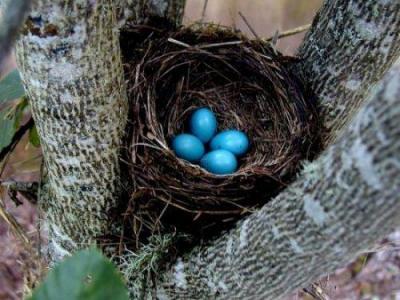
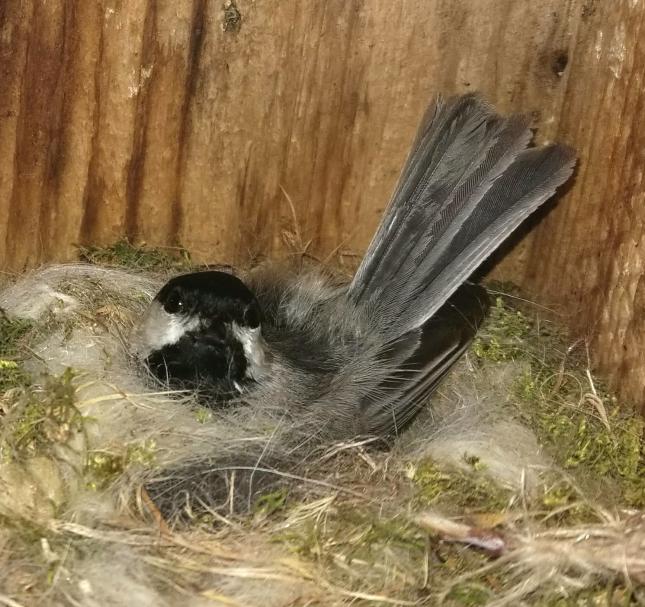
Nesting Season...It's here!
Did you know that for most of our backyard birds nesting season lasts from February or March until August or September?
Studies show that when birds have access to feeders during nesting season they have more successful broods.
By providing food throughout the nesting season you are helping to increase the bird population.
Meeting Your Birds' Nesting Needs | Fledging Facts | It Ain't Over 'Til It's Over | Provide Calcium | Other Tips
Monitoring Nest Boxes | Features of a Good Nest Box | Found A Baby Bird - What to Do |
Meeting Your Birds' Nesting Needs
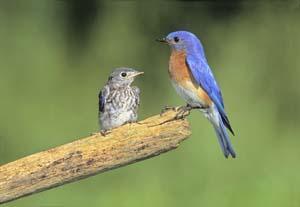 Parents introduce their children to a world of new experiences. The same can be said for the birds that will be raising their young in your backyard this season.
Parents introduce their children to a world of new experiences. The same can be said for the birds that will be raising their young in your backyard this season.
You don't want to miss out on many fun and fascinating wild bird "family life" activities. Full feeders provide an opportunity to see adult birds as they take some time away from the duties of raising their young.
Recent research studies show that birds with access to bird feeders often lay their eggs earlier than those without feeders. This is significant because earlier broods typically have better rates of survival and fledging success than later ones.
Feeders also allow breeding females to spend less time searching for food and more time selecting better nesting sites and constructing higher quality nests. The adults will also have more time available for protecting their nest, eggs, and young from predators.
When abundant food is accessible to parent birds it means that more food is provided to their chicks. Studies have shown that this extra nutrition reduces aggression among nest siblings and increases their rate of growth.
As broods of fledglings leave the nest they are being fed and taught to eat from feeders by their parents, a fascinating interaction to observe. Look for the young birds as they follow their parents to the feeder.
Fledgling Facts
Here are some characteristics and behaviors to look for when watching these baby birds as they begin to leave the nest:
 Fledglings are about the same size as adults, but often their plumage color is muted and similar to adult females.
Fledglings are about the same size as adults, but often their plumage color is muted and similar to adult females.- In some species, fledglings' tails are shorter than the adults', because the tail feathers are still growing.
- You can recognize Downy and other woodpecker fledglings by their fresh and dapper plumage, whereas that of the adults is worn and dusky from their repeated trips in and out of the nest hole.
- Chickadee fledglings follow their parents to the bird feeder and perch nearby as the parents go to get food. They either wait, looking like they are waiting to be served, or they call incessantly "teeship teeship" and flutter their wings until fed.
- After one to three weeks, the parents stop feeding their fledglings and may even peck at them if they persist in begging for food to get them to feed themselves.
It Ain't Over 'Til It's Over
Remember that many of our birds will have two, three, and even four broods per spring/summer. Click here for the Nesting Chart of the birds in our area.
Provide Calcium
Feeding foods with added calcium like our Plus Blends, Bark Butter Bits, and No-Mess Blend NM CD will aid in strong egg production.
Other Tips
Watch for robins and mockingbirds to dart in and out of trees and shrubs. This is a sure indicator that their nest is present. Try putting raisins and mealworms on a ground-feeding tray in your yard to entice them to take a snack.
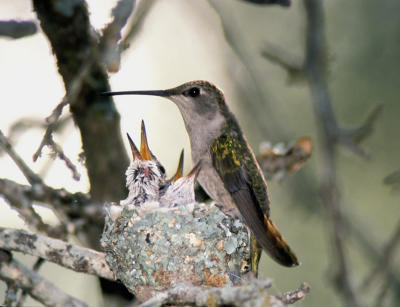 Check your nesting boxes for chickadees, titmice, or wrens raising families. Again, it's fun to place mealworms nearby for the busy parent.
Check your nesting boxes for chickadees, titmice, or wrens raising families. Again, it's fun to place mealworms nearby for the busy parent.
Goldfinches will be increasing their daily intake of seed in preparation for their nesting period starting this month, so watch for great activity on your thistle feeders.
Providing a source of water is by far the best way to draw less common birds to your backyard, especially if there has been a long, hot, dry spell. Run your dripper or mister consistently and you might be able to lure thrushes, warblers, or others.
Summertime is one of the best time to enjoy the fruits of your labor, knowing that you make a difference in the lives of birds!
Monitoring Nest Boxes
One of the most important tasks of being a responsible nest box landlord is to monitor your nest boxes for invasive species.
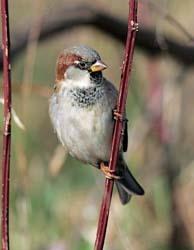 English House Sparrows and European Starlings are not native to North America. House Sparrows were brought over on the mistaken premise that they would help reduce crop insect pests. Starlings were brought over by a Shakespeare fanatic who had 60 pairs of all the birds that were mentioned in the plays of Shakespeare brought from Europe. Their populations have exploded across North America and they are now two of the most abundant species here. Not only are they crowding out our native birds but House Sparrows and Starlings are notorious for breaking open eggs and pecking other birds to death by piercing their skulls in their efforts to take over a nesting site.
English House Sparrows and European Starlings are not native to North America. House Sparrows were brought over on the mistaken premise that they would help reduce crop insect pests. Starlings were brought over by a Shakespeare fanatic who had 60 pairs of all the birds that were mentioned in the plays of Shakespeare brought from Europe. Their populations have exploded across North America and they are now two of the most abundant species here. Not only are they crowding out our native birds but House Sparrows and Starlings are notorious for breaking open eggs and pecking other birds to death by piercing their skulls in their efforts to take over a nesting site.
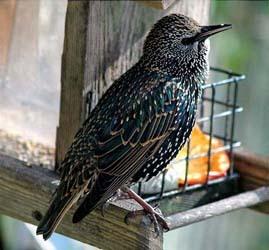 Bluebirds and purple martins nest, for the most part, in man-made birdhouses which are usually erected in areas of human habitation. These habitats are also preferred by the House Sparrow and Starling.
Bluebirds and purple martins nest, for the most part, in man-made birdhouses which are usually erected in areas of human habitation. These habitats are also preferred by the House Sparrow and Starling.
If the sparrows or starlings have built a nest in a nest box or house you should remove the nest and eggs. Be sure you're removing the nest of an English House Sparrow or European Starling. All other native backyard birds are protected by the federal government.
How to Monitor a Nest Box
-
Check the box once a week only on calm, mild, dry days.
-
Limit your viewing time to a minute.
-
Approach the box slowly and lightly tap on the side of the box to give the adult bird a chance to leave.
-
Open the box carefully.
-
Examine the nesting material and any eggs to determine which species are using the box.
-
Dispose of non-native species' nest materials and eggs.
Features of a Good Nest Box
There are many types of nest boxes. Some are simply decorative and do not meet the physical requirements of the birds you want to attract to your yard. We recommend functional boxes, which may also be decorative, but will provide your birds with the following:
-
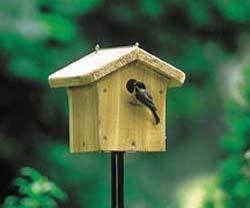 The entry hole must be the right size: large enough for the specific bird to get in, yet small enough to keep other birds out.
The entry hole must be the right size: large enough for the specific bird to get in, yet small enough to keep other birds out. -
The wood should be at least 3/4 of an inch thick to provide insulation.
-
The box does not need additional paints or stains.
-
You should be able to open a panel to monitor nesting activity and clean the box after its use.
-
The roof should be slanted so water can run off easily.
-
Ventilation holes at the top allow the interior to remain cool.
-
Perches on the front of the box are not recommended, as this gives predators an advantage.
-
Each species prefers a nesting box at a particular height above the ground and in the right habitat - see ‘Nesting Chart’
-
Baffles will keep raccoons, squirrels, cats, and other predators out of the box.
Found A Baby Bird? What Do You Do?
The best thing to do if you find a baby bird is to leave it alone. If the bird appears as though it has fallen from a nest, an attempt to locate the nest can be made, and the bird can be carefully returned. If the bird has feathers, it may be a fledged bird and a parent bird is probably close by. As long as the bird is in no danger from cats or other predators, it is best to watch the bird from a distance to see if a parent returns after an hour or so before determining that the bird needs human help.
Birds do not have a true sense of smell, so the myth that birds will reject a baby bird if touched by a human is not true. A baby bird that has been touched by a human, however, does make it easier for a predator (cat, raccoon, etc.) to find.
If a nest cannot be located or the bird is "rescued," the first important step is to call a rehabilitator to care for the bird. Second, provide warmth to the baby bird. A hot water bottle or heating pad on a low setting or even hot water in a glass bottle will do.
Taking care of injured birds and wildlife should be left to people who know how to do it best. Contact Owl's Nest Sanctuary for Wildlife for help with an orphaned bird.


